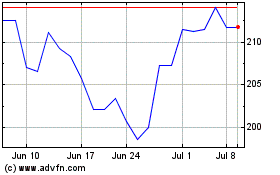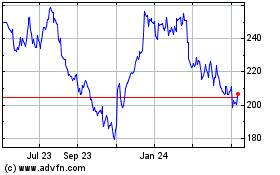Nearly Half of Women Whose Partners Experience
Urinary Symptoms Say Those Symptoms Affect Their Lives as Well,
Most Often in the Form of Sleep
Teleflex Incorporated (NYSE: TFX), a leading global provider of
medical technologies for critical care and surgery, has announced
that a common health problem that affects nearly 40 million men in
the United States often impacts more than just the health of the
sufferer, new data suggests. Two surveys sponsored by NeoTract
Interventional Urology were recently deployed to more than 1,000
men and 1,000 women over the age of 50 in the U.S. with the aim of
measuring the impact of a frequently undiagnosed men’s health issue
on couples, as well as to ascertain the reasons why men may not be
seeking treatment. The results demonstrated that, while men may not
be communicating about their symptoms or aware of their impact, the
lives of their partners are often affected by them.
Benign prostatic hyperplasia (BPH), also known as enlarged
prostate, is non-cancerous enlargement of the prostate that occurs
as men age. The condition, which affects more than 40% of men over
50, is marked by bothersome urinary symptoms that can cause loss of
productivity, depression, and decreased quality of life. One of the
most common symptoms, interrupted sleep, has recently been linked
to shortened life span, cancer, heart attacks, and Alzheimer’s,
according to research by leading neuroscientist Matthew
Walker.1
When women were asked about their partners’ urinary symptoms, 43
percent said they were aware that their significant other was
experiencing symptoms of BPH. The most common symptom identified,
by far, was getting up in the night to urinate. Of the women whose
partners were experiencing symptoms, 42 percent said those symptoms
affect their lives in at least one way. The biggest impact occurred
at night, with 64 percent saying their partners’ symptoms affected
their sleep. Nearly one-third said symptoms influenced social life
and vacations, and 39 percent said their relationship with their
significant other was impacted.
The majority of men surveyed were experiencing BPH symptoms, and
also identified sleep as the main issue:
- 55 percent said they were experiencing
at least one symptom of BPH, 46 percent were experiencing multiple
symptoms
- Of those experiencing symptoms, 68
percent said those symptoms affect their life in some way. The most
common complaint was sleep (affecting 56 percent), followed by
travel, social life, and work.
- More than one-third were not aware
these symptoms were signs of a treatable condition, rather than
just a result of aging.
The survey also found that while 82 percent of men said they
regularly wake up at least once in the night to urinate, the
majority said the nighttime waking did not bother their significant
other (82 percent). In contrast, the impact on sleep was the top
issue for women whose significant others experienced symptoms,
suggesting that men may not be aware of the effect their symptoms
have on those around them.
“When it comes to prostate issues, men are typically reluctant
to speak with a doctor about their symptoms," said Dr. David
Sussman2, a urologist with Delaware Valley Urology in New Jersey.
“For those who have seen a doctor, the BPH treatments most often
discussed have long been associated with sexual dysfunction, making
the symptoms sometimes more appealing to live with than the
treatment options. But a new treatment, called the UroLift System,
offers effective symptom relief with minimal side effects,
preserves prostate tissue and does not cause sexual dysfunction.
It’s a rapid, minimally invasive procedure that can be performed
right in the urologist’s office, making it an appealing option for
men who have been hesitant to seek treatment.”
Medication is often the first-line therapy for enlarged
prostate, but relief can be inadequate and temporary. Side effects
of medication treatment can include sexual dysfunction, dizziness
and headaches, prompting many patients to quit using the drugs. For
these patients, the classic alternative is surgery that cuts, heats
or removes prostate tissue to open the blocked urethra. Of the men
surveyed:
- 86 percent said preserving sexual
function was of importance when considering treatment
- 60 percent said preserving prostate
tissue was of importance when considering treatment
- 74 percent said the risk of
incontinence and impotence would likely factor into their decision
when considering treatment
“These survey results, in conjunction with the growing body of
evidence pointing towards the importance of sleep, reinforce the
need for continued education on the true impact of BPH,” said Dave
Amerson, president and general manager of NeoTract Interventional
Urology, a medical device company focused on addressing unmet needs
in the field of urology, and sponsor of the surveys. “It’s a fairly
common misperception that these symptoms are harmless and just an
inevitable part of aging, and as a result, many men and their
partners are dealing with the effects unnecessarily, and
potentially putting themselves at risk for other health
conditions.”
BPH is not a pre-cursor to prostate cancer, but is twelve times
more common, especially as men age. Over 40 percent of men in their
50s have BPH and over 70 percent of men in their 60s have the
condition. The incidence rate climbs to 80 percent for men over the
age of 70. If BPH is left untreated, the condition can worsen over
time and cause permanent bladder damage.
“We hope this new data sparks a dialogue between men and their
partners on the impact of BPH on each other’s lives, and that it
encourages more men to speak with their doctor about symptoms they
are experiencing,” said Ana Fadich, vice president of Men’s Health
Network. “BPH only becomes more and more common as men age, so
early intervention can really make a difference in quality of life
and long-term health, both for men and their loved ones.”
About the UroLift System
The FDA-cleared UroLift System is a novel, minimally invasive
technology for treating lower urinary tract symptoms due to benign
prostatic hyperplasia (BPH). The UroLift permanent implants,
delivered during a minimally invasive transurethral outpatient
procedure, relieve prostate obstruction and open the urethra
directly without cutting, heating, or removing prostate tissue.
Clinical data from a pivotal 206-patient randomized controlled
study showed that patients with enlarged prostate receiving UroLift
implants reported rapid and durable symptomatic and urinary flow
rate improvement without compromising sexual function. Patients
also experienced a significant improvement in quality of life. Most
common adverse events reported include hematuria, dysuria,
micturition urgency, pelvic pain, and urge incontinence. Most
symptoms were mild to moderate in severity and resolved within two
to four weeks after the procedure. The UroLift System is available
in the U.S., Europe, Australia and Canada. Learn more at
www.UroLift.com.
About the UroLift System
The FDA-cleared UroLift System is a proven, minimally invasive
technology for treating lower urinary tract symptoms due to benign
prostatic hyperplasia (BPH). The UroLift permanent implants,
delivered during a minimally invasive transurethral outpatient
procedure, relieve prostate obstruction and open the urethra
directly without cutting, heating, or removing prostate tissue.
Clinical data from a pivotal 206-patient randomized controlled
study showed that patients with enlarged prostate receiving UroLift
implants reported rapid and durable symptomatic and urinary flow
rate improvement without compromising sexual function. Patients
also experienced a significant improvement in quality of life. More
than 45,000 men worldwide have been treated with the UroLift
System. Most common adverse events reported include hematuria,
dysuria, micturition urgency, pelvic pain, and urge incontinence.
Most symptoms were mild to moderate in severity and resolved within
two to four weeks after the procedure. The UroLift System is
available in the U.S., Europe, Australia, Canada, Mexico and South
Korea. Learn more at www.UroLift.com.
About NeoTract | Teleflex Interventional Urology
A wholly owned subsidiary of Teleflex Incorporated, the NeoTract
Interventional Urology Business Unit is dedicated to developing
innovative, minimally invasive and clinically effective
devices that address unmet needs in the field of urology. Our
initial focus is on improving the standard of care for
patients with BPH using the UroLift System, a minimally
invasive permanent implant system that treats symptoms while
preserving normal sexual function. Learn more
at www.NeoTract.com.
About Teleflex Incorporated
Teleflex is a global provider of medical technologies designed
to improve the health and quality of people’s lives. We apply
purpose driven innovation – a relentless pursuit of identifying
unmet clinical needs – to benefit patients and healthcare
providers. Our portfolio is diverse, with solutions in the fields
of vascular and interventional access, surgical, anesthesia,
cardiac care, urology, emergency medicine and respiratory care.
Teleflex employees worldwide are united in the understanding that
what we do every day makes a difference. For more information,
please visit www.teleflex.com.
Teleflex is the home of Arrow®, Deknatel®, Hudson RCI®, LMA®,
Pilling®, Rusch® and Weck® – trusted brands united by a common
sense of purpose.
1 The Guardian: “The Shorter Your Sleep, the Shorter Your Life:
The New Sleep Science.“ http://bit.ly/2xZXEdR MAC00599-01 Rev C 2
Dr. David Sussman is a paid consultant of NeoTract.
View source
version on businesswire.com: http://www.businesswire.com/news/home/20180214005829/en/
Teleflex IncorporatedJake Elguicze, 610-948-2836Treasurer and
Vice President, Investor RelationsorMedia Contact:Nicole Osmer,
650-454-0505nicole@healthandcommerce.com
Teleflex (NYSE:TFX)
Historical Stock Chart
From Mar 2024 to Apr 2024

Teleflex (NYSE:TFX)
Historical Stock Chart
From Apr 2023 to Apr 2024
